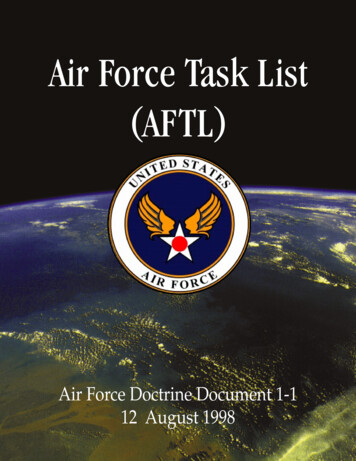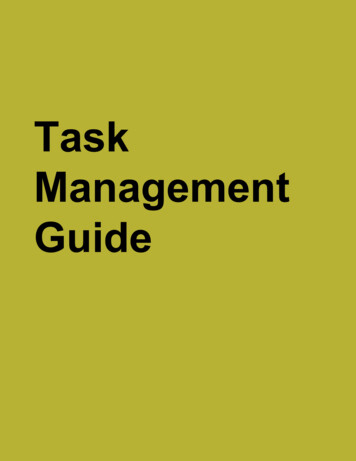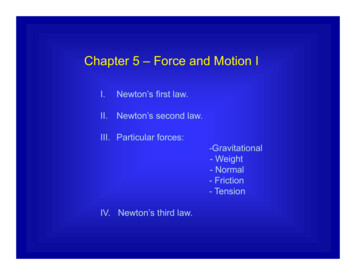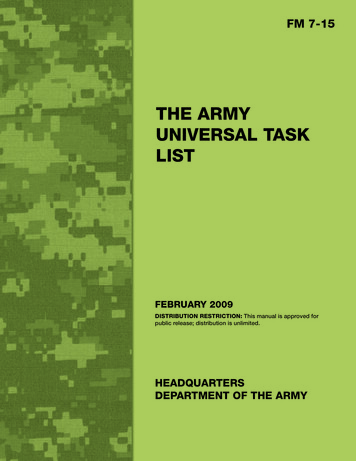
Transcription
Air Force Task List(AFTL)Air Force Doctrine Document 1-112 August 1998
BY ORDER OF THESECRETARY OF THE AIR FORCEAIR FORCE DOCTRINE DOCUMENT 1-112 August 1998OPR: HQ AFDC/DJ (Lt Col Charles D. Sutherland, USAF)Certified by: AFDC/CC (Maj Gen Ronald E. Keys, USAF)Pages: 201Distribution: FApproved by: MICHAEL E. RYAN, General, USAFChief of Staff
FOREWORDAerospace power is a dynamic and unique element of modern joint warfare. This Air ForceTask List (AFTL) provides a comprehensive framework for all of the tasks that the AirForce performs in contribution to national defense. These tasks include Air Force capabilitiesprovided in support of the joint force commander (JFC) across the spectrum of conflict andoperations, as well as the tasks required of the Air Force to organize, train, equip, and providecapable aerospace forces.This AFTL provides a comprehensive framework that is flexible enough to meet the needs ofall Air Force organizations. To accomplish this, the AFTL is structured on Air Force corecompetencies and their command and control (C2). Each core competency is enabled by a menuof “capabilities” tasks. These tasks are broken down into four subtasks: perform, educate andtrain, equip, and plan. In addition, many of the perform tasks are broken down further wheregreater detail is required to organize a capability composed of wide ranging specialties. Finally,Air Force organizations are authorized and encouraged to expand on the lower-level tasks inorder to express their mission-specific requirements. This final detailing provides the necessaryflexibility for major air commands (MAJCOMs), numbered air forces (NAFs), and units todevelop accurate and organization-specific Mission Essential Task Lists (METLs) which willidentify the organization-specific essential tasks that must be performed to designated standardsunder specified conditions. Through this task assurance process a commander will have the toolsand indications to provide a continuous picture of the overall mission performance health of theorganization. Careful application of the AFTL and METL approach will insure our wingsstay mission-healthy, our headquarters stay focused on the critical and important tasks,and we remain the most respected Air Force in the world.MICHAEL E. RYANGeneral, USAFChief of Staff12 August 1998i
ii
TABLE OF CONTENTSPageINTRODUCTION .vCHAPTER ONE—Tasks and Task Lists .112233334Mission Essential Task (MET) .Supporting Task .Enabling Task .Command-linked Task .Mission Essential Task List (METL) .Joint Mission Essential Task List (JMETL) .Universal Joint Task List (UJTL) .Air Force Task List (AFTL) .CHAPTER TWO—METL Development Process .Know Your Mission .Who, When, and Where .How .What .Step 1: Identify the MET .Step 2: Determine the Conditions .Step 3: Establish Measures and Standards .CHAPTER THREE—METL Utility and Applicability .Planning .Assurance .Operational Assurance .Compliance Assurance .Task Assurance .JMETL Inputs .Future Utility .CHAPTER FOUR—Air Force Task List (AFTL).Task Organization .Core Tasks .Capability Tasks.Tasks that Provide Capabilities.Performance Tasks .Adding to the Task List .References .Points to Remember as Tasks are Added/Modified 021
CHAPTER FIVE—Conditions for Air Force Tasks .Conditions .Development of Conditions .Organization of Conditions .CHAPTER SIX—Measures for Air Force Tasks .What are Standards .Measure .Criterion .Setting Standards .Multiple Measures .Expressing Standards .Development of Measures .Organization of Measures .Some Final Words on Measurements .Operational Definition .Measurement .Measurement Presentation .2323232427272727282828283030323232APPENDIXA METL Format . 33B METL Development Examples . 55C Air Force Task List . 79D Conditions for Air Force Tasks . 159Glossary . 191iv
INTRODUCTIONPURPOSEThis document has been prepared under the direction of the Chief of Staff of the Air Force(CSAF). Aerospace forces provide valuable capabilities that can be applied across the full rangeof military operations from global nuclear or conventional warfare to military operations otherthan war (MOOTW). This document establishes general doctrinal guidance for the developmentof mission essential tasks (METs) using the Air Force Task List (AFTL) and related conditionsand measures.APPLICATIONThis Air Force Doctrine Document (AFDD) applies to all active duty, Air Force Reserve, AirNational Guard, and civilian Air Force personnel. The doctrine in this document is authoritativebut not directive. Therefore, commanders need to consider not only the contents of this AFDD,but also the particular situation when accomplishing their missions.SCOPEAir Force assets (people, weapons, and support systems) can be used across the range ofmilitary operations at the strategic, operational, and tactical levels of war. AFDD 1-1 discussesthe development of METs and Mission Essential Task Lists (METLs) using the AFTL. Chapterone of the AFTL defines tasks and illustrates the relationship between the AFTL, METLs, JointMission Essential Task List (JMETL), and the Universal Joint Task List (UJTL). Chapter twodescribes the three steps in the METL development process, while Appendix B provides thedetailed examples to the wing level. Chapter three covers the utility and application of theMETLs. In addition to these demonstrations, Appendix A explains the format for publishingMETLs, complete with the tasks of a notional wing METL, expanded with supporting tasks,expressed as group and squadron METLs. Chapter four describes how the comprehensiveframework for expressing all Air Force tasks is organized, while Appendix C contains the list.Chapter five describes how conditions are developed and used, while Appendix D contains thelist of conditions affecting task performance. Finally, chapter six contains information on howmeasures are developed and used with Air Force tasks, while the suggested measures themselvesfollow their respective tasks in Appendix C.JOINT DOCTRINEThis document is consistent with, and complements, Chairman of the Joint Chiefs ofStaff Manual (CJCSM) 3500.04A, Universal Joint Task List; Joint Pub 1-02, DODDictionary of Military and Associated Terms; and Department of Defense Directive (DODD)5100.1, Functions of the Department of Defense and Its Major Components; but its purposeis to promulgate the Air Force perspective on the employment of aerospace power. As suchit focuses on how Air Force assets can be organized, trained, equipped, and operated toconduct and support joint operations.v
vi
CHAPTER ONETASKS AND TASK LISTSTalent and genius operate outside the rules, and theory conflicts with practice.Major General Carl von ClausewitzOn WarA task is a discrete event or action, not specific to a single unit, weapon system, orindividual, that enables a mission or function to be accomplished—by individuals ororganizations. Discrete means that a task will only be listed once although the relationshipsbetween a particular task and multiple other tasks may be complex (i.e., one task supports orenables other tasks.) This definition is the basis for the development of every task in thisdocument, AFDD 1-1, Air Force Task List, and CJCSM 3500.04A, Universal Joint Task List.As tasks are used in association with specific missions of particular organizations, they take onmore detailed definitions. This chapter explains the different types of tasks and the relationshipbetween the Air Force Task List (AFTL) and the Universal Joint Task List (UJTL).MISSION ESSENTIAL TASK (MET)A mission essential task (MET) is a task selected or expanded on from the AFTL as afundamental requisite for the performance or accomplishment of an organization’s assignedmission. An organization should have a limited number of METs. While all tasks performed inthe Air Force are important, most are performed to support or enable the essential tasks that arethe reasons each particular organization exists. Keeping that in mind, it is possible to narrowdown the list of METs to only those tasks that represent the indispensable tasks to that particularorganization. A MET includes not only the task but also associated conditions and measures.The MAJCOM commander approves the standards set for the performance of the tasks when heapproves the METL. At echelons below the MAJCOM, there is a collaborative METLdevelopment process; however, the approval authority resides with the MAJCOMcommander. The process is described in detail in chapter two and notional examples areprovided in Appendix B to demonstrate this process in detail. Conditions are variables of the environment or situation in which a unit, system, orindividual is expected to operate in, and which affect performance. They are categorizedby conditions of the physical environment (e.g., climate, objects in space, or terrain), militaryenvironment (e.g., threat, command relationships), and civil environment (e.g., political,cultural, and economic factors). Some conditions are designed to help describe the theater ofoperations (e.g., host-nation support), others describe the immediate operational area (e.g., airsuperiority), while still others describe the battlefield conditions (e.g., vegetation). Whenlinked to tasks, conditions help frame the differences or similarities between assignedmissions. Conditions are discussed in detail in chapter five and the comprehensive list ofconditions are in Appendix D. Measures of effectiveness provide a way to describe how an organization or force mustperform a task under a specific set of conditions for a specific mission. The measures1
provide a vehicle to express the minimum acceptable proficiency required in the performanceof a particular task, which are called standards. These standards, when linked to conditions,provide a basis for planning, conducting, and evaluating a mission or training event. Themeasures that follow each task in Appendix C are only suggestions. During thecollaborated METL development process, the organization may select measures from the list,modify them as needed, or create different measures as needed for any task. Additions orcorrections to the measures will be added to subsequent revisions of this publication in aneffort to maintain a common language throughout like Air Force organizations. Allwartime/contingency requirements should be considered when setting standards. Insetting standards, it is important to remember that efficiency does not necessarily equate toeffectiveness. For example, the US Air Force was very efficient at “servicing targets” duringROLLING THUNDER, of the Vietnam War, but that efficiency did not convert toeffectiveness, as far as obtaining the desired end state.SUPPORTING TASKA supporting task is specific activity thatcontributes to the accomplishment of a missionessential task. Supporting tasks areaccomplished at the same command level or bysubordinate elements of a force. For example, afighter wing may select AFT 1.1.1.2 ConductDefensive Counterair as a MET. That task issupported by AFT 2.1.1 Perform LethalPrecision Engagement, AFT 7 ProvideCommand and Control, AFT 6.1.1.9.1 PerformUnit Level Maintenance, AFT 6.3.1.6 ProvideEach mission essential task is supported by manytasks that provide the synergy required forOperations Support, and a host of more detailedsuccessful accomplishment.tasks performed within the wing. While thosetasks are arguably “essential” to the accomplishment of AFT 1.1.1.2, they are not descriptors ofthe mission essential tasks of a wing.ENABLING TASKAn enabling task is specific activity that makes it possible to accomplish a mission essentialtask. Successful completion of an enabling task does not guarantee the accomplishment of aMET; however, unsuccessful completion will most assuredly result in failing to accomplish theMET. The enabling task concept shows the relationship of the tasks as a “house of cards.” Thefailure to accomplish many of the capability tasks in AFT 6 Provide Agile Combat Support andAFT 3 Provide Information Superiority will result in the failure of most of the subordinate tasksin AFT 1 Provide Air and Space Superiority, AFT 2 Provide Precision Engagement, AFT 4Provide Global Attack, and AFT 5 Provide Rapid Global Mobility. For example, failure toaccomplish AFT 5.1.2 Educate and Train Airlift Operations Forces, AFT 6.2.1 Protect the Force,or AFT 6.5.1.3 Perform Air Mobility Support, will eventually prevent the acceptableaccomplishment of AFT 5.1.1 Perform Airlift. Another example: failure to accomplish AFT6.1.1.12 Recruit and Access a Quality Force, most assuredly will result in the eventual failure toaccomplish any of the tasks throughout the AFTL. If all enabling tasks were listed as METs in2
each organization, the list would become excessively long, unmanageable, and thereby of little orno utility to the organization.COMMAND-LINKED TASKThe joint training environment uses command-linked tasks to depict the interface betweensupported and supporting commands and agencies. These tasks are key to accomplishingsupported command or agency joint mission essential tasks (JMETs). The supported commandernormally designates and assesses the command-linked tasks. The command performing the tasknormally evaluates task accomplishment. Close coordination and communication are requiredbetween supported and supporting commands.MISSION ESSENTIAL TASK LIST (METL)A METL is the complete list of METs for any organization. A set of mission-based requiredcapabilities are identified through an analysis of an assigned or anticipated mission. Since AFTLtasks are not specific to a single unit, weapon system, or individual, multiple organizations canuse the same tasks to develop their particular METL. Like organizations should have likeMETLs. METLs should be labeled with the name of the organization that accomplishes them(e.g., Air Mobility Command [AMC] METL; Eighth Air Force [8 AF] METL; 1st Fighter Wing[1 FW] METL; etc.) See chapter two for detailed examples of METL development.JOINT MISSION ESSENTIAL TASK LIST (JMETL)A joint force commander’s list of priority joint tasks, derived from plans and orders, alongwith associated conditions and measurable standards, constitutes the joint force commander’swar-fighting requirements and is called a Joint Mission Essential Task List (JMETL). Acommand’s JMETL provides the basis to derive training objectives for training events. It is alsothe basis for the commander’s assessment of command training events. The Joint TrainingMaster Plan (CJCSI 3500.02) and the Joint Training Manual (CJCSM 3500.03) describe inmore detail how a command’s JMETL supports the joint training system. Each Air Forceorganization should consider their responsibilities to meet the requirements of anyapplicable JMETLs, along with all other mission requirements, as they build their METL.UNIVERSAL JOINT TASK LIST (UJTL)The UJTL is designed as a comprehensive list of tasks using a common language for jointforce commanders (JFCs). The current version, illustrated in figure 1.1, is vertically structuredaround the levels of war. The strategic level is subdivided into the strategic national andstrategic theater levels, giving the impression of four levels of war. Approved joint doctrine andcurrent Service doctrine of the US Air Force and the other Services adhere to the concept of onlythree levels of war: strategic, operational, and tactical. The UJTL’s horizontal structure reflectsa relationship with the Army’s traditional battlefield operating systems (BOS). While the BOShave served the Army in organizing and performing needed tasks on the battlefield, they areinsufficient to organize or to reflect the potential of aerospace power. Future versions of theUJTL should reflect the capabilities of the entire joint community. Since the UJTL concept isgrowing in influence and importance in determining requirements for the military3
community, all future developments of the UJTL should be followed closely with full USAir Force participation in the review process.Accomplish Objectives ofSN 1CONDUCTSTRATEGICDEPLOYMENT &REDEPLOYMENTSTRATEGIC NATIONALSN 2SN 3SN Accomplish Objectives ofST 1DEPLOY,CONCENTRATEAND MANEUVERTHEATER FORCESST 2DEVELOPTHEATERSTRATEGICISRST 3EMPLOYTHEATERSTRATEGICFIREPOWERSTRATEGIC THEATERST 4SUSTAINTHEATERFORCESAccomplish Objectives ofOP 1CONDUCTOPERATIONALMOVEMENT & MANEUVEROP 2PROVIDEOPERATIONALISRST 5PROVIDE THEATERSTRATEGICCOMMANDAND CONTROLOPERATIONALOP 3EMPLOYOPERATIONALFIREPOWERAccomplish Objectives ofTA 1DEPLOY/CONDUCT MANEUVERTA 2DEVELOPINTELLIGENCENaval Tactical Task ListNational Military StrategySN 5PROVIDESTRATEGICDIRECTION& INTEGRATIONSN 7CONDUCTFORCEDEVELOPMENTST 6PROVIDETHEATERPROTECTIONST 7ESTABLISH THEATERFORCEREQUIREMENTSAND READINESSST 8DEVELOP ANDMAINTAIN ALLIANCEAND REGIONALRELATIONSSubordinate Campaigns and Major OperationsOP 5EXERCISEOPERATIONALCOMMAND & CONTROLOP 6PROVIDEOPERATIONALPROTECTIONBattles and EngagementsTA 4PERFORM LOGISTICS ANDCOMBAT SERVICE SUPPORTArmy Tactical Task ListSN 8FOSTER MULTINATIONAL ANDINTERAGENCYRELATIONSTheater and Campaign StrategyOP 4PROVIDEOPERATIONALSUPPORTTACTICALTA 3EMPLOYFIREPOWERSN 6CONDUCTMOBILIZATIONTA 5EXERCISE COMMAND& CONTROLTA 6PROTECTTHE FORCEAir Force Tactical Task ListFigure 1.1. Universal Joint Task List (UJTL) Version 3.0AIR FORCE TASK LIST (AFTL)The AFTL, illustrated in figure 1.2, provides the comprehensive framework to express all AirForce activities contributing to the defense of the nation and its national interests. Founded onthe Air Force’s core competencies and their command and control, the AFTL remainscongruent with established Air Force doctrine and compliant with the functions as assignedto the US Air Force by Title 10, United States Code (U.S.C.), and the Department ofDefense (DOD).The AFTL complements the UJTL by providing Air Force specific tasks. In addition, itoffers a modern structure for eventual inclusion into that manual. While this modern structuredoes not numerically align Air Force tasks with the traditional battlefield operating structurepresent in version 3.0 of the UJTL, the tasks are functionally related.4
Air Force Task ListPROVIDE AIR AND SPACESUPERIORITY AFT 1PROVIDE PRECISIONENGAGEMENT AFT 2PROVIDE INFORMATIONSUPERIORITY AFT apabilitiesProvide LethalPrecisionEngagementCapabilitiesProvide iesAFT 1.1AFT 1.2AFT 2.1AFT 2.2AFT 2.3AFT 3.1PROVIDE RAPID GLOBAL MOBILITY AFT 5PROVIDE GLOBAL ATTACK AFT e SpecialOperations tiesProvide esProvide AirExpeditionaryForce (AEF)CapabilitiesAFT 4.1AFT 4.2AFT 4.3AFT 4.4AFT 5.1AFT 5.2AFT 5.3AFT 5.4PROVIDE AGILE COMBAT SUPPORT AFT 6Provide theCapability toReady the ForceProvide theCapability toProtect the ForceProvide the Capabilityto Prepare theOperationalEnvironmentProvide theCapability toPosition the ForceProvide theCapability toEmploy the ForceProvide theCapability toSustain the ForceProvide theCapability toRecover the ForceAFT 6.1AFT 6.2AFT 6.3AFT 6.4AFT 6.5AFT 6.6AFT 6.7PROVIDE COMMAND AND CONTROL AFT 7Monitor GlobalConditions andEventsAssess GlobalConditions andEventsAFT 7.1PlanMilitaryOperationsAFT 7.2ExecuteMilitaryOperationsAFT 7.3AFT 7.4Figure 1.2. Air Force Task List (AFTL)The UJTL structure implies a restriction of the Services’ task lists to a position under itstactical level of war tasks. However, since aerospace forces operate at all levels of war, theAFTL contains tasks that may occur at the strategic and operational levels of war, as well as thetactical level of war. Figure 1.3 demonstrates the relationship between the tasks that stem fromthe core competencies and the tasks that represent the traditional tactical level of warfare asdescribed in the UJTL. Figures 1.4 through 1.6 demonstrate the relationship between the tasksthat stem from the core competencies to the tasks that represent the operational and strategiclevels of war in the UJTL.Air & Space SuperiorityPrecision EngagementInformation SuperiorityGlobal AttackRapid Global MobilityAgile Combat SupportCommand & rm Logistics &Combat Service SupportTA5ExerciseCommand &ControlXXXXXXXXXTA6Protect theForceFigure 1.3. AFTL Tasks in Relationship to UJTL “Tactical Level of War” Tasks5XXXXXXX
The relationships illustrated in figures 1.3through 1.6 do not mean that every task undereach core competency always fits under all of themarked UJTL categories, under all conditions, forall missions. It does mean that AFTs may berelated to any of a number of the UJTLcategories, depending on the particulars ofeach mission that require the task development.The AFTL provides a common language for thebroad concepts and a framework for expressingThese Security Forces demonstrate thatairmen operate at the tactical level of war.the more detailed tasks of the Air Force. Theflexibility of aerospace power requires the use ofgood judgement from subject matter experts in expressing the lowest details of any particularevent.Just as the Air Force tasks may beassociated with several of the currentUJTL’s categories of tasks, the sameapplies to the UJTL’s categories bylevel of war. The description of a taskdoes not always determine that it isoperating at a specific level of war.The particulars of each mission willdetermine whether the tasksperformed by the Air Force are atwhich level of war. It is quitepossible that an Air Force task will beoperating at multiple levels of warThis Peacekeeper demonstrates that airmen operate at thesimultaneously. This multiplicity ofstrategic level of war.levels-of-war relationship, illustratedin figure 1.7, does not detract from thetactical expertise required of aerospace warriors as they alter the operational and strategic levelof war environments. However, it does insist that aerospace power be recognized as the strategicinstrument of power that it is.OP1OP2Conduct OperationalProvideMovement &Operational ISRManeuverAir & Space SuperiorityPrecision EngagementInformation SuperiorityGlobal AttackRapid Global MobilityAgile Combat SupportCommand & XXXXXXOP4ProvideOperationalSupportOP5Exercise OperationalCommand & XXXXFigure 1.4. AFTL Tasks in Relationship to UJTL “Operational Level of War” Tasks6
ST1ST2Deploy,DevelopConcentrate andTheaterManeuverStrategic ISRTheater ForcesAir & Space SuperiorityPrecision EngagementInformation SuperiorityGlobal AttackRapid Global MobilityAgile Combat SupportCommand & rStrategic 8EstablishDevelop &Theater Force Maintain AllianceRequirements && RegionalReadinessRelationsXXXXXXXXXXXXFigure 1.5. AFTL Tasks in Relationship to UJTL “Strategic Theater Level of War” TasksThe objective, not the means selected, determines the level of war. Commanders need to understand therange of choices available to them through the flexibility of aerospace power.SN1SN2ConductDevelopStrategicStrategic ISRDeployment &RedeploymentAir & Space SuperiorityPrecision EngagementInformation SuperiorityGlobal AttackRapid Global MobilityAgile Combat SupportCommand & inmentXXXXXXXSN5SN6SN7SN8ProvideConductConduct ForceFosterStrategic Mobilization Development MultinationalDirection && XXXXFigure 1.6. AFTL Tasks in Relationship to UJTL “Strategic National Level of War” TasksAerospace power is inherently capable of operating at all levels of war. Aerospacepower uses lethal and nonlethal means to create strategic, operational, and tactical effects inorder to achieve objectives. The nature of operations that can mold the strategic, operational,and tactical environments with the same activity are difficult to divide by level of war.Consequently, it adds no value to a task to associate it with a particular level of war, unless theassociation is merely for a single, particular scenario where the determination is required. It isenvisioned that future versions of the UJTL will be structured on the core competencies of the7
combatant commands with an eventual link to the capabilities of the i
document, AFDD 1-1,Air Force Task List, and CJCSM 3500.04A, Universal Joint Task List. As










